This article needs additional citations for verification .(July 2021) |

Palazzo Bembo is a palace in Venice, Italy, on the Grand Canal, close by the Rialto Bridge and next to the Palazzo Dolfin Manin.
This article needs additional citations for verification .(July 2021) |

Palazzo Bembo is a palace in Venice, Italy, on the Grand Canal, close by the Rialto Bridge and next to the Palazzo Dolfin Manin.
It was built by the noble family of Bembo in the 15th century. Although it was remodeled several times over the centuries, externally it still maintains the original structure. The building is on the San Marco side of the Grand Canal, wedged in between Rio di San Salvador and Calle Bembo.
Palazzo Bembo is the birthplace of Pietro Bembo (1470–1547), a Venetian scholar, poet, literary theorist, and cardinal. He was an influential figure in the development of the Italian language, specifically Tuscan, as a literary medium. His writings assisted in the 16th century revival of interest in the works of Petrarch. Bembo's ideas were also decisive in the formation of the most important secular musical form of the 16th century, the madrigal.
Today the building hosts a hotel and a contemporary art exhibition venue.
The Palazzo's red façade is decorated with poliforas and combines old Venetian elements with influences from Byzantine architecture. The facade is considered to be an example of the Venetian Gothic-Byzantine style, a style of architecture originated in 14th-century Venice with the confluence of Byzantine styles from Constantinople, Arab influences from Moorish Spain, and early Gothic forms from mainland Italy. Palazzo Bembo's 17th century restoration took on influences from that period, as exhibited in its polychromy, three-part façade, and loggias.
With the thriving of Venice Biennale in the city, Palazzo Bembo is currently known for its Venice Biennale art exhibitions organized by Personal Structures, an international contemporary art platform. [1] [2]

The Grand Canal is a channel in Venice, Italy. It forms one of the major water-traffic corridors in the city.
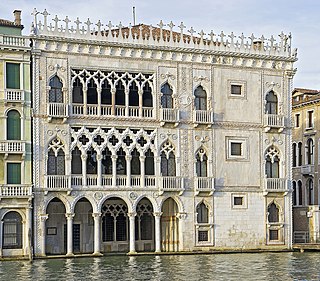
The Ca' d'Oro or Palazzo Santa Sofia is a palace on the Grand Canal in Venice, northern Italy. One of the older palaces in the city, its name means "golden house" due to the gilt and polychrome external decorations which once adorned its walls. Since 1927, it has been used as a museum, as the Galleria Giorgio Franchetti.

Palazzo Labia is a baroque palace in Venice, Italy. Built in the 17th–18th century, it is one of the last great palazzi of Venice. Little known outside of Italy, it is most notable for the remarkable frescoed ballroom painted 1746–47 by Giovanni Battista Tiepolo, with decorative works in trompe-l'œil by Gerolamo Mengozzi-Colonna.

Palazzo Grassi is a building in the Venetian Classical style located on the Grand Canal of Venice (Italy), between the Palazzo Moro Lin and the campo San Samuele.

The Fondaco dei Turchi is a Veneto-Gothic style palazzo, later on named as the Turks' Inn, on the Grand Canal of Venice, northeast Italy.

Venetian Gothic is the particular form of Italian Gothic architecture typical of Venice, originating in local building requirements, with some influence from Byzantine architecture, and some from Islamic architecture, reflecting Venice's trading network. Very unusually for medieval architecture, the style is both at its most characteristic in secular buildings, and the great majority of survivals are secular.

Palazzo Malipiero is a palace in Venice, Italy. It is on the Grand Canal in the central San Samuele square. It stands just across from the Palazzo Grassi Exhibition Center.

Gothic architecture appeared in the prosperous independent city-states of Italy in the 12th century, at the same time as it appeared in Northern Europe. In fact, unlike in other regions of Europe, it did not replace Romanesque architecture, and Italian architects were not very influenced by it. However, each city developed its own particular variations of the style. Italian architects preferred to keep the traditional construction methods established in the previous centuries; architectural solutions and technical innovations of French Gothic were seldom used. Soaring height was less important than in Northern Europe. Brick rather than stone was the most common building material, and marble was widely used for decoration. In the 15th century, when the Gothic style dominated both Northern Europe and the Italian Peninsula, Northern Italy became the birthplace of Renaissance architecture.
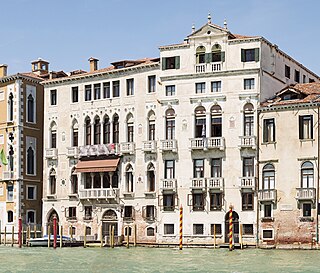
The Palazzi Barbaro—also known as Palazzo Barbaro, Ca' Barbaro, and Palazzo Barbaro-Curtis—are a pair of adjoining palaces, in the San Marco district of Venice, northern Italy. They were formerly one of the homes of the patrician Barbaro family. The Palazzi are located on the Grand Canal of Venice, next to the Palazzo Cavalli-Franchetti and not far from the Ponte dell'Accademia. The buildings are also known as the Palazzo Barbaro-Curtis. It is one of the least altered of the Gothic palaces of Venice.
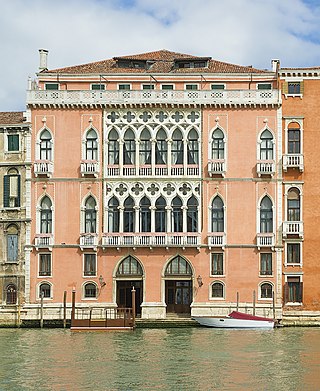
Palazzo Pisani Moretta is a palace situated along the Grand Canal in Venice, Italy, between Palazzo Tiepolo and Palazzo Barbarigo della Terrazza.
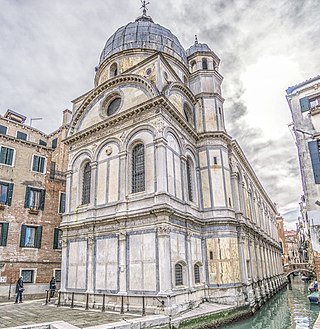
Venetian Renaissance architecture began rather later than in Florence, not really before the 1480s, and throughout the period mostly relied on architects imported from elsewhere in Italy. The city was very rich during the period, and prone to fires, so there was a large amount of building going on most of the time, and at least the facades of Venetian buildings were often particularly luxuriantly ornamented.
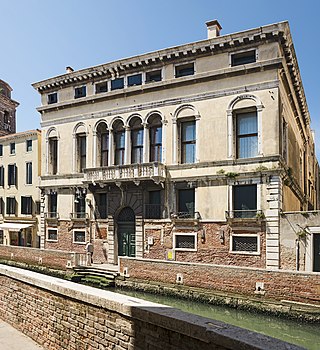
Ca Bembo is a grade-listed sixteenth-century palazzo in the parish of San Trovaso in the sestiere of Dorsoduro in Venice, Italy, noteworthy for a particularly large garden. It has, despite its name, no clear connection with the Bembo family, but a particularly strong association with one of the most prominent branches of the aristocratic Venetian family of the Barbarigo.
Ca’ Sanudo Turloni is a Gothic-style palace located with a façade on Rio de Sant'Antonio, and located in Calle Pezzana #2162, in the Sestiere San Polo in Venice, Italy.

The Palazzo da Mula is a Venetian villa on the island of Murano in the Venice Lagoon, on the sub-island of San Pietro Martire, on the south bank of the Canale degli Angeli, near the Ponte Vivarini bridge that leads to the main island of Murano, San Donato. The palazzo is the last remnant of Venetian villas built in Murano in the 15th and 16th centuries. Originally there were only a few villas with extensive gardens on the island, but today the Palazzo da Mula is integrated into a row of houses. The 16th and 17th-century structure and details of the palazzo can be traced back to the Da Mula family, who had acquired the palazzo from the aristocratic Diedo family in 1621. The Da Mulas resided in this palazzo until 1712, when it was rented to the aristocratic family of Giacomo Fontanella, a member of the new aristocracy of glass masters, for a sum of 110 ducats. The property then passed to Giacomo's son, Zuanne Fontanella.

The Palazzo Pisani Gritti is a Venetian Gothic palazzo located on the north side of the Grand Canal, opposite the Church of the Salute, between the Campo del Traghetto and the Rio de l'Alboro, in the Sestieri of San Marco, Venice, Italy. It was the residence of Doge Andrea Gritti in the 16th century. It is now the Gritti Palace Hotel.
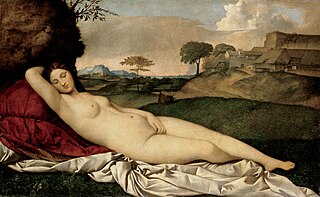
The Venetian Renaissance had a distinct character compared to the general Italian Renaissance elsewhere. The Republic of Venice was topographically distinct from the rest of the city-states of Renaissance Italy as a result of their geographic location, which isolated the city politically, economically and culturally, allowing the city the leisure to pursue the pleasures of art. The influence of Venetian art did not cease at the end of the Renaissance period. Its practices persisted through the works of art critics and artists proliferating its prominence around Europe to the 19th century.

Palazzo Contarini Dal Zaffo, also known as Palazzo Contarini Polignac is a large palace in Venice, located in the Dorsoduro district, overlooking the Grand Canal, in an intermediate position between Palazzo Brandolin Rota and Palazzo Balbi Valier.
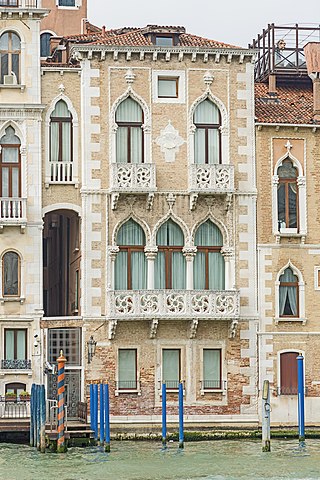
Palazzo Contarini Fasan is a small Gothic palace in Venice, Italy, located in the San Marco district and overlooking the Grand Canal. The palazzo is also called the House of Desdemona.

Palazzo Civran Grimani is a Neoclassical palace in Venice, Italy. The palazzo is located in the San Polo district, overlooking the Grand Canal at the confluence with Rio della Frescada, between Palazzo Dandolo Paolucci and Palazzo Caotorta-Angaran.

Palazzo Michiel del Brusà is a palace located in Venice, more precisely in the Cannaregio district, and overlooking the Grand Canal. The building is located between Palazzo Michiel dalle Colonne and Palazzo Smith Mangilli Valmarana.